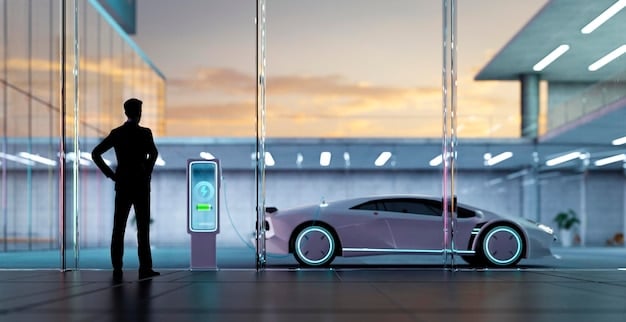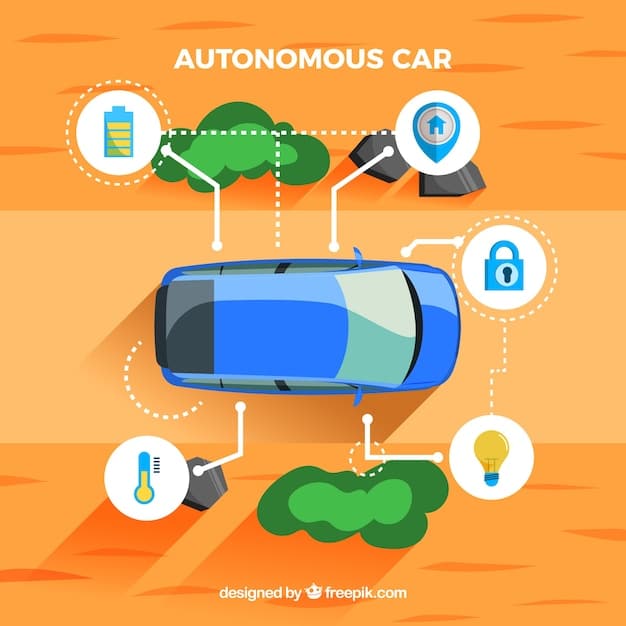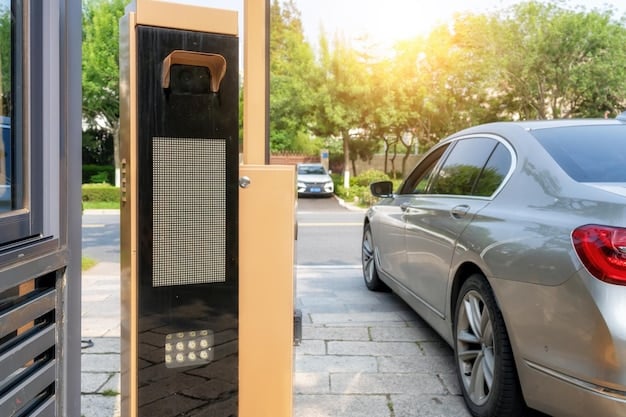Wireless EV Charging: Is This the Future of Electric Vehicles?

Wireless charging for electric vehicles (EVs) is an emerging technology that offers a convenient alternative to traditional plug-in charging, potentially revolutionizing how EVs are powered and integrated into our daily lives through automated and seamless energy transfer.
The evolution of electric vehicles is accelerating, and with it comes the demand for more convenient and efficient charging solutions. Is Electric Vehicle Technology Advancement: Wireless Charging for Electric Vehicles – Is This the Future of Electric Vehicle Charging? the key to unlocking mainstream EV adoption?
Understanding Wireless Charging for Electric Vehicles
Wireless charging, also known as inductive charging, is a method of transferring electrical energy from a power source to an electric vehicle without the need for a physical cable. This technology utilizes electromagnetic fields to transmit energy across a gap, offering a hands-free and potentially more convenient way to charge EVs.
How Wireless Charging Works
Wireless charging systems typically involve two main components: a transmitting pad and a receiving pad. The transmitting pad is connected to a power source and generates an alternating electromagnetic field. The receiving pad is integrated into the EV and converts the electromagnetic field back into electrical energy, which then charges the vehicle’s battery.
Types of Wireless Charging
There are primarily two types of wireless charging technologies: inductive charging and resonant inductive charging. Inductive charging requires the transmitting and receiving pads to be very close together, while resonant inductive charging allows for a slightly larger gap between the pads. Both methods offer similar benefits in terms of convenience and ease of use.
- Convenience: Wireless charging eliminates the need to handle cables and connectors.
- Automation: Charging can be automated, starting as soon as the vehicle is parked over the charging pad.
- Aesthetics: No cables cluttering driveways or public spaces.
Wireless charging represents a significant step forward in EV technology, offering a seamless and user-friendly charging experience. As the technology matures and becomes more widely adopted, it has the potential to transform how we power our electric vehicles.

Benefits of Wireless Charging for EVs
The advantages of wireless charging extend beyond mere convenience. This technology promises a range of benefits for EV owners, grid operators, and the environment. From enhanced user experience to increased efficiency and grid stability, wireless charging is set to redefine the EV landscape.
Enhanced User Experience
Wireless charging simplifies the charging process, making it as easy as parking your car. This ease of use can significantly improve the overall EV ownership experience, encouraging more people to switch to electric vehicles. No more fumbling with cables in the dark or in inclement weather.
Increased Charging Efficiency
While early wireless charging systems had lower efficiency compared to wired charging, advancements in technology are closing this gap. Modern wireless systems are designed to minimize energy loss and maximize the amount of energy transferred to the vehicle’s battery. Improvements in resonant inductive charging have helped boost efficiencies.
Grid Stability and Smart Charging
Wireless charging can be integrated with smart grid technologies to optimize charging times and reduce strain on the grid. By scheduling charging during off-peak hours or when renewable energy sources are abundant, wireless charging can contribute to grid stability and lower electricity costs.
- Convenience and ease of use for EV owners.
- Potential for increased charging efficiency with technology advancements.
- Integration with smart grid for optimized charging and grid stability.
Wireless charging offers a multitude of benefits that can accelerate the adoption of electric vehicles and support a sustainable energy future. Its potential to improve user experience, increase efficiency, and enhance grid stability makes it a compelling technology for the future of transportation.
Challenges and Limitations of Wireless Charging
Despite its many advantages, wireless charging is not without its challenges. Addressing these limitations is crucial for the widespread adoption of this technology. Factors such as efficiency, cost, standardization, and safety need to be carefully considered and overcome.
Efficiency and Energy Loss
One of the primary challenges of wireless charging is energy loss during the transfer process. The efficiency of wireless charging systems is typically lower than that of wired charging, meaning some energy is lost as heat. Research and development are focused on improving the efficiency of wireless charging coils and power electronics to minimize these losses.
Cost and Infrastructure Development
The cost of installing wireless charging infrastructure can be significant, especially for public charging stations. The cost includes the charging pads themselves, as well as the necessary grid upgrades and installation expenses. As demand for wireless charging increases, economies of scale may help drive down costs.
Standardization and Interoperability
Lack of standardization is another barrier to the widespread adoption of wireless charging. Different manufacturers use different charging protocols, which can limit interoperability between vehicles and charging stations. Industry-wide standards are needed to ensure that any EV can charge wirelessly at any charging station.

- Lower efficiency compared to wired charging.
- High costs of infrastructure development and installation.
- Lack of standardization and interoperability between different systems.
Overcoming these challenges will be essential for wireless charging to become a mainstream technology. Efforts are underway to improve efficiency, reduce costs, establish standards, and ensure safety, paving the way for a more convenient and sustainable EV charging experience.
The Current State of Wireless EV Charging Technology
Wireless EV charging is no longer a concept of the future; it’s a developing technology with real-world applications. Several companies are actively working to improve and implement wireless charging solutions for electric vehicles. These efforts are crucial to evaluate the real-world implementation of the technology and to understand the market’s current needs.
Companies and Projects in Wireless Charging
Several companies are at the forefront of wireless EV charging technology, developing solutions for both static (parked) and dynamic (in-motion) charging. WiTricity, for instance, is one of the key players, providing wireless charging solutions to automakers and infrastructure providers. Other companies like Qualcomm and Momentum Dynamics are also making significant contributions.
Pilot Programs and Real-World Implementations
Pilot programs and real-world implementations are essential to test the feasibility and effectiveness of wireless charging. Cities around the world are launching pilot programs to evaluate wireless charging for electric buses, taxis, and personal vehicles. These projects provide valuable data on the performance, reliability, and user acceptance of wireless charging.
Advancements in Technology
Advancements in materials, power electronics, and control systems are driving improvements in wireless charging technology. Researchers are developing new magnetic materials to enhance the efficiency of wireless charging coils. Innovations in power electronics are reducing energy losses and improving the overall performance of wireless charging systems.
The current state of wireless EV charging technology is marked by significant progress and growing interest. As companies continue to innovate and launch pilot programs, wireless charging is moving closer to becoming a mainstream solution for electric vehicles.
The Future of Wireless Charging for Electric Vehicles
The future of wireless charging for electric vehicles looks promising, with potential advancements that could revolutionize the way we power our EVs. Innovations in technology, infrastructure, and standardization will play a key role in shaping the future of wireless charging and its widespread adoption, impacting how EVs and the grid interact.
Potential Advancements in Technology
Future advancements in wireless charging technology are expected to focus on improving efficiency, increasing power transfer capabilities, and reducing costs. Researchers are exploring new materials and designs for wireless charging coils that can minimize energy losses and maximize power transfer. High-frequency switching devices can also play a large part in the adoption of wireless charging because of higher efficiency.
Impact on Infrastructure and Urban Planning
Wireless charging could have a significant impact on infrastructure and urban planning. The integration of wireless charging into parking spaces, roads, and public transportation systems could transform how cities are designed and how people use electric vehicles. Wireless charging pads could be embedded in roads to allow EVs to charge while driving, extending their range and reducing the need for frequent stops.
The Role of Standardization
Standardization will be crucial for the widespread adoption of wireless charging. Industry-wide standards will ensure interoperability between different vehicles and charging stations, making it easier for EV owners to charge their vehicles wirelessly regardless of the location or manufacturer. Organizations such as the Society of Automotive Engineers (SAE) are working to develop standards for wireless charging systems.
- Potential advancements in efficiency, power transfer, and cost reduction.
- Expected impact on infrastructure and urban planning.
- Crucial role of standardization for interoperability and adoption.
The future of wireless charging for EVs holds tremendous potential. As technology advances, infrastructure develops, and standards emerge, wireless charging is poised to become a key component of the electric vehicle ecosystem. These developments will affect not only the lives of consumers but will affect how the vehicles interact with the grid.
How Wireless Charging Compares to Traditional Charging Methods
To fully appreciate the potential of wireless charging, it’s important to compare it with traditional charging methods, such as plug-in charging. Each method has its own advantages and disadvantages in terms of convenience, speed, efficiency, and cost. This comparison offers insight into the specific situations for which wireless charging may be especially useful.
Convenience and Ease of Use
Wireless charging offers a significant advantage in terms of convenience. Plug-in charging requires EV owners to physically connect a cable to their vehicle, which can be inconvenient in certain situations. Wireless charging eliminates this step, making the charging process as simple as parking your car.
Charging Speed and Efficiency
Plug-in charging generally offers faster charging speeds and higher efficiency compared to current wireless charging systems. Wired charging connections provide a direct and efficient transfer of energy, while wireless charging involves some energy loss due to the electromagnetic field. However, advancements in wireless technology are closing this gap.
Cost and Infrastructure
The cost of installing plug-in charging infrastructure is generally lower than that of wireless charging. Plug-in chargers are relatively simple and affordable, while wireless charging systems require more complex and expensive components. However, as wireless charging technology matures, costs are expected to decrease.
- More convenience and an easing of use for everyday applications.
- Wired charging connections provide efficient and fast power transfer.
- Plug-in hardware costs are far less than a dynamic charging system.
Wireless charging provides a promising alternative to traditional charging methods, offering convenience and ease of use. While challenges remain in terms of speed, efficiency, and cost, ongoing advancements in technology are paving the way for wireless charging to become a mainstream solution for electric vehicles.
| Key Point | Brief Description |
|---|---|
| ⚡Wireless Charging Basics | Uses electromagnetic fields to transfer energy without cables. |
| ✅Benefits | Enhances user convenience and grid stability. |
| 🚧Challenges | Addresses efficiency, cost, and standardization hurdles for widespread adoption. |
| 🚀Future Impact | Could revolutionize urban planning and EV infrastructure. |
FAQ Section
▼
Wireless charging uses electromagnetic fields to transfer energy from a charging pad to a receiver in the EV, eliminating the need for cables. The vehicle simply parks over the pad to initiate charging.
▼
While early wireless charging systems had lower efficiency, modern systems are improving. Plug-in charging is still generally more efficient, but advancements are narrowing the gap between the two methods.
▼
Key benefits include convenience (no cables needed), automation (charging starts automatically), and potential for smart grid integration (optimized charging times and lower costs).
▼
Limitations include lower efficiency compared to plug-in charging, higher infrastructure costs, and lack of industry-wide standards for interoperability between different systems and vehicles.
▼
The future involves advancements in efficiency, power transfer, and cost reduction. It also includes potential impacts on urban planning and the crucial role of standardization for widespread adoption across the EV industry.
Conclusion
In conclusion, Electric Vehicle Technology Advancement: Wireless Charging for Electric Vehicles – Is This the Future of Electric Vehicle Charging? offers a compelling vision for the future of EV charging. While challenges remain, ongoing advancements and pilot programs suggest that wireless charging has the potential to transform the EV landscape, making it as simple as parking your car.





